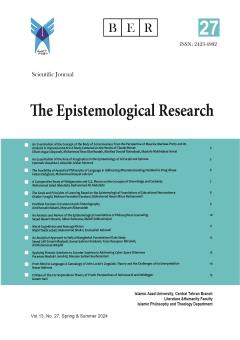Examining the concept of the body of consciousness from the perspective of Maurice Merleau-Ponty and its analysis in the works of impressionism style: relying on the works of Claude Monet
Subject Areas : Epistemological researches
elham asgari abyaneh
1
![]() ,
Mohammad Reza Sharifzadeh
2
*
,
Mohammad Reza Sharifzadeh
2
*
![]() ,
abolfazl davodi roknabadi
3
,
mostafa mokhtabad amrai
4
,
abolfazl davodi roknabadi
3
,
mostafa mokhtabad amrai
4
1 - department of art philosophy&;central tehran branch&;islamic azad university'tehran'iran
2 - Professor of Department of Philosophy of Art, Faculty of Art, Islamic Azad University, Central Tehran Branch
3 - design&clothing departement'yazd branch'islamic azad university'yazd'iran
4 - department of deramatic literature'tarbiat modares university'tehran'iran
Keywords: : perception, conscious-body, Merleau-Ponty, impressionism, Claude Monet,
Abstract :
Merleau-Ponty, like other existentialist philosophers, believes that every human being has a special situation, position and existence in the world, that this existence is a product of being-in-the-world, and on the other hand, man, from his point of view, is a special situation and being-in-the-world. - Experiences the world. And the body makes the living man find himself and his existence. In this article, an attempt is made to evaluate Merleau-Ponty's attitude about the two previous concepts in the works and the attitude of the Impressionists and the works of Claude Monet as an example. Monet's works express Merleau-Ponty's conscious body experience, which portrays the situation he perceives based on living and being-in-the-world. In fact, this being in the world, in Merleau-Ponty's interpretation, is the same way of life that the impressionists use for illustration, and it has become their painting style. The main question of the article is that considering that Merleau-Ponty believes that human connection with the outside world is based on sensory perception, and on the other hand, art, especially painting, is a manifestation of sensory perception, is the attitude of the Impressionists, including Claude Monet, also in drawing the outside world? Is it like Merleau-Ponty's attitude or not? Because Claude Monet also achieves a special kind of sensory and visual perception of the outside world by using light in his paintings, and this makes Monet aligned with Merleau-Ponty's thinking.
پاکباز، روئین (1386)، دایرة المعارف هنر. چ6، تهران: فرهنگ معاصر.
پاینده، حسین (1391)، داستان کوتاه در ایران. ج 2، چ 2، تهران: نیلوفر.
پرنیان، ماندانا (1385)، بررسی تطبیقی امپرسیونیسم در نقاشی، ادبیات و موسیقی. کتاب ماه هنر، ش 99 و 100، آذر و دی، ص 89-76.
پیراوی ونک، مرضیه (1389)، پدیدارشناسی نزد مرلوپونتی، چ 1، اصفهان: نشر پرسش.
زایتس، ویلیام (1373)، کلود مونه. ترجمه حسن افشار، تهران: نشر مرکز.
کارمن، تیلور (1390)، مرلو-پونتی. ترجمه مسعود اولیا. تهران: نشر ققنوس.
لاکست، ژان (1392)، فلسفه هنر. ترجمه محمدرضا ابوالقاسمی. تهران: نشر ماهی.
ماتیوز، اریک (1389)، درآمدی بر اندیشههای مرلوپونتی. ترجمه رمضان برخوردار. تهران: نشرگام نو.
مرلوپونتی، موریس (1391)، جهان ادراک. ترجمه فرزاد جابر الانصار. تهران: نشر ققنوس.
Callagher, Shaun (2010). Merleau-ponty's phenomenology of perception, Topoi: an International Review of Philosophy, vol. 29, No. 2, pp. 183-185.
Dunstan, Bernard (1976). Painting Methods Of the Impressionisis. New York: Watson-Guptill Publication.
Gunderson, Jessica (2009). Impressionism. Mankato: Creative Education.
Jacobson, K (2010). The experience of home and the space of citizenship. The Southern Journal of Philosophy, vol. 48, no. 3, pp. 219-245.
Lyon, Christopher (1991). “Unveiling Monet”, Mo MA 7.
Merleau-Ponty, Maurice (2005). Phemenology of Perception, Translated by colin smith, Newyork &London: Routledge.
Romdenh-Romluc, Komarine (2010), Routledge philosophy Guide Book toMerleau- Ponty and Phemenologhy of Precception, London & Newyork: Routledge.
Tucker, Paul H (1995). Claude Monet: Life and Art. New Haven: Yale UP.

